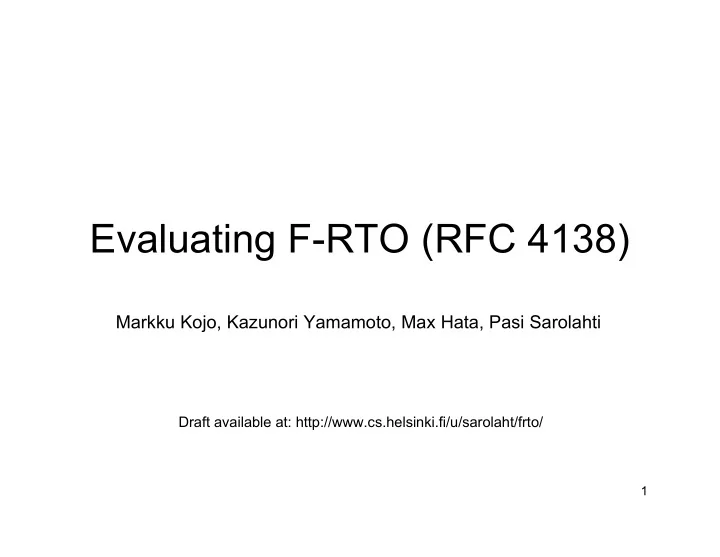

Evaluating F-RTO (RFC 4138) Markku Kojo, Kazunori Yamamoto, Max Hata, Pasi Sarolahti Draft available at: http://www.cs.helsinki.fi/u/sarolaht/frto/ 1
History • Experimental RFC 4138, Aug 2005 • A number of known F-RTO implementations are out there • Experimentations have been carried with several implementations showing positive results • Proposals to advance to PS have been expressed earlier • Advancing to PS was discussed in IETF-67 – We were asked to write a document that • Points out the problems with regular RTO recovery and usefulness of F-RTO • Evaluates F-RTO to show it is not harmful to the network, corner cases included • Summarizes experimentation results • As a first step: – We wrote Internet-Draft "Evaluation of RFC 4138" • <draft-kojo-tcpm-frto-eval-00b.txt> (not yet in repositories) • Available at: http://www.cs.helsinki.fi/u/sarolaht/frto/ 2
Spurious RTOs on Regular TCP • Delay spikes occur on wireless networks due to – handoffs – link-layer error recovery – bandwidth variation • Delay spike may trigger TCP retransmission timer Spurious RTO • Problems: Unnecessary Delay spike retransmissions – Regular TCP sender retransmits whole window unnecessarily in slow start – Network resources are wasted – Dishonors packet conservation principle – In many cases severe performance penalty to the TCP flow 3
Spurious RTO due to vertical handoff from a low-latency to high-latency access link Another RTO needed to recover losses Segments dropped due to the burst Spurious RTO Handoff completes at 9,9 sec 4
Spurious RTO and F-RTO • When delay spike causes RTO to expire, retransmit 1 st unacknowledged segment • 1 st ACK acknowledges the Continue transmitting new data retransmission: send 2 new segments Transmit two • 2 nd ACK acknowledges data new segments that was not retransmitted: RTO is declared spurious Spurious RTO • Benefits of F-RTO: – Avoids unnecessary retransmissions – Allows adhering to packet Delay spike conservation principle – Prevents the TCP flow from severe performance penalty – Enables RTT samples from delayed segments 5
Can F-RTO be harmful? NO! • If RTO is not spurious (or F-RTO fails to detect) – F-RTO reverts back to traditional RTO recovery – Exactly same amount of segments get transmitted • Hidden losses when F-RTO declares RTO spurious – A few known scenarios 1. Loss of the unnecessary RTO retransmission 2. Severe reordering – retransmitted segment bypasses the full window of original segments 3. Malicious receiver – Delays ACKs until RTO expires and retransmitted segment arrives – ACKs data it has not received – 1 & 2 considered as rare corner cases; won’t harm TCP flow – With 3 benefit is questonable; concealing losses harms TCP flow – None of these can harm the network, if conservative response is taken • F-RTO sender is recommended to take the spurious RTO as a congestion signal 6
Next Steps • Revise RFC 4138 targeting at PS – Specify basic algorithm and TCP only – Leave the following as experimental and do not include in the Standards Track specification • F-RTO with SCTP • SACK-Enhanced variant of F-RTO – Response? • do not specify any response in the new draft, or • recommend implementing conservative response, i.e., take spurious RTO as a congestion signal – possibly include guidelines for a conservative response – Maybe specify a conservative response in a separate document? 7
Recommend
More recommend